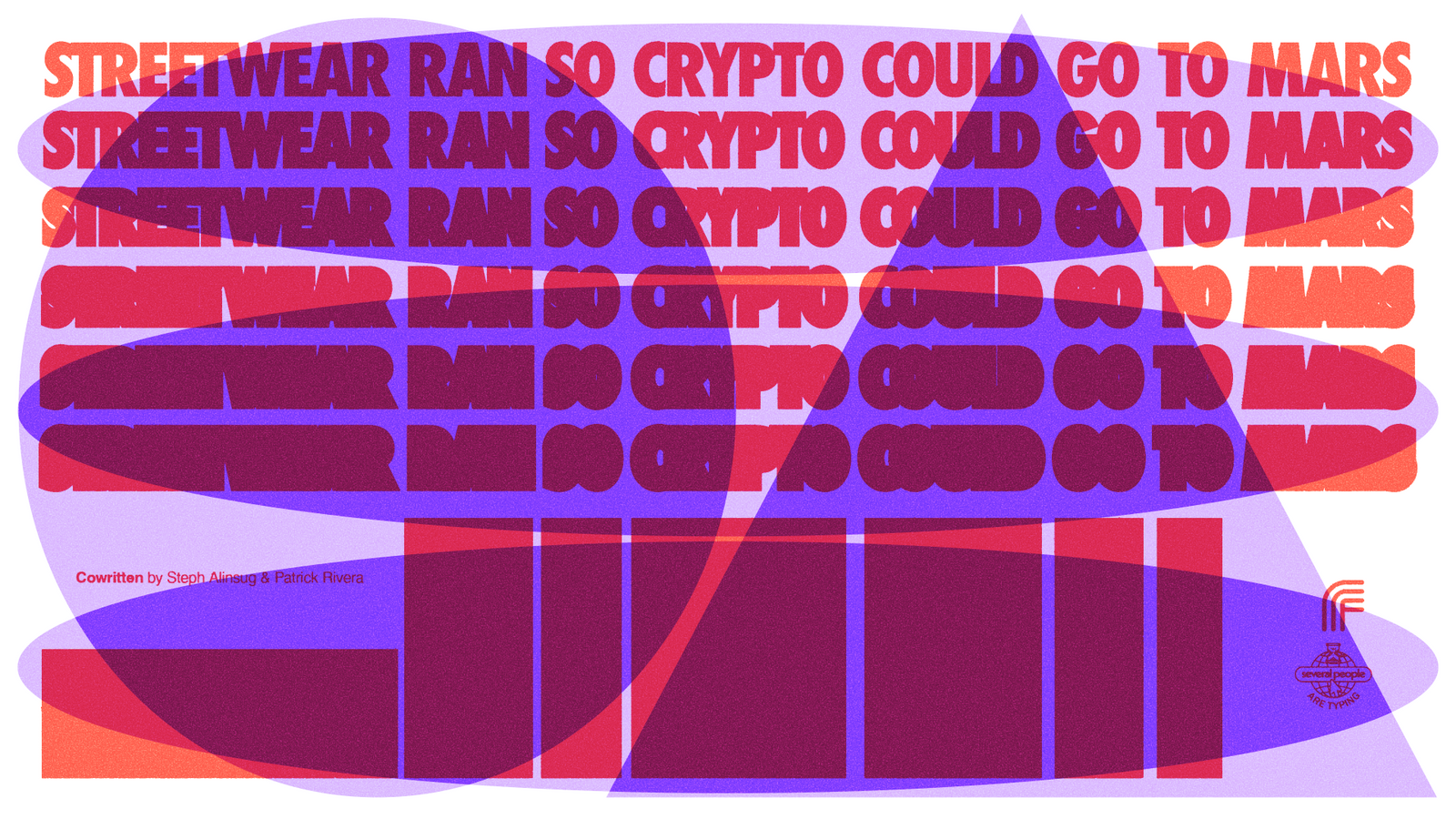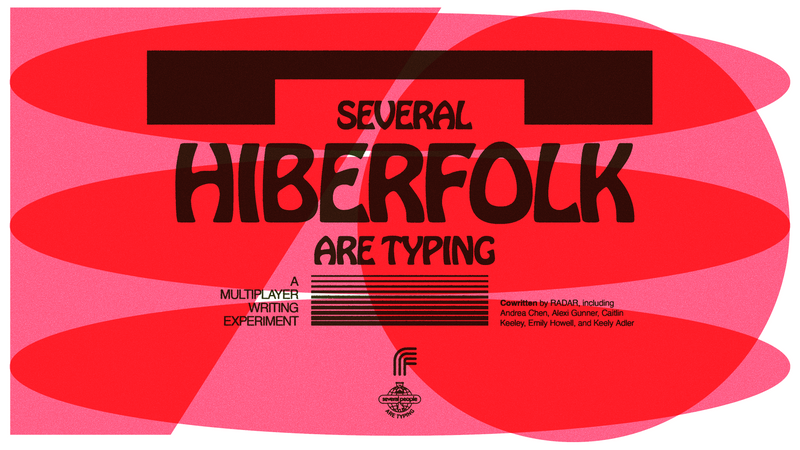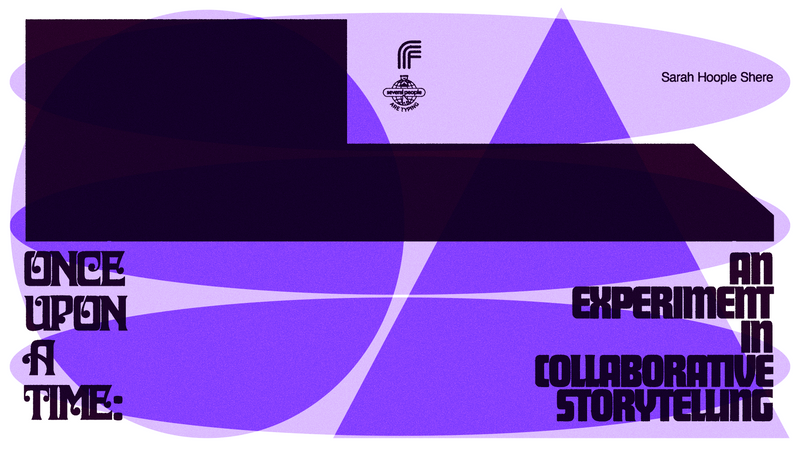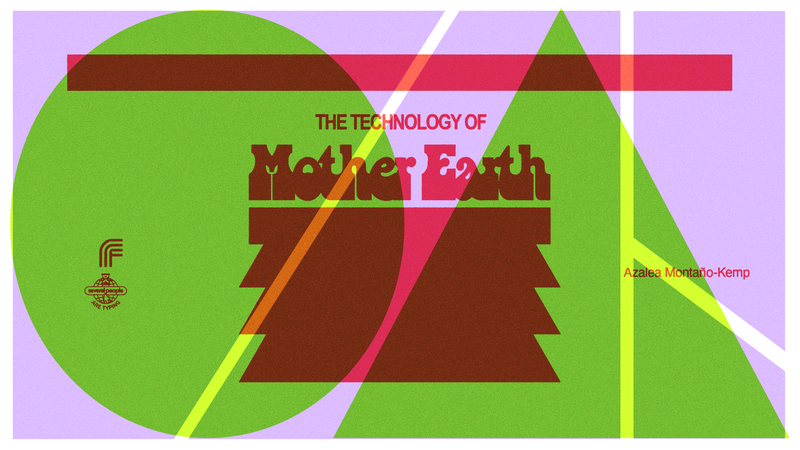This piece was co-authored by Steph Alinsug and Patrick Rivera.
Streetwear is our original culture hacker that uses the internet, media, and narrative to catalyze micro-cultural production in a disaffected demographic. Through creative collaborations, fusing digital/physical experiences, maximalist branding, and employing missionary-like proliferation tactics, streetwear demonstrates what’s possible when geographically dispersed people connect through cultural memes on the internet.

The Internet Brought Us Together
Both crypto and streetwear are characterized by a rejection of traditional (read: centralized) institutions coupled with a desire for autonomy and self-expression. Both of these verticals tap into the currently undervalued TAM of grown adults who have chips on their shoulders. And we don’t see anything wrong with that; we might even call it worldbuilding.
One of my (Steph) most beloved pieces of clothing are my Pleasures socks. They’re a basic cotton/poly/spandex-blend crew. My favorite of the two pairs is the lime green, featuring the word “PLEASURES” in a nondescript sans serif lilac stitching, visible above the sneaker line. (For those wondering, the other pair is brown with yellow stitching.) Honestly, I feel sexy wearing these socks with my white and red Salomon Ultra Raids, as if I’m walking around with a visible inside joke for everyone to miss out on.
The Pleasures site harkens back to an aughties-era internet but with a UX-sensibility benched to our current technological future. It feels nostalgic and veteran but also performs the way a 2023 Range Rover does: with irreverence but fucking capable. It’s like a giant middle finger to every snot-nosed popular kid archetype we may or may not have been bullied by. A simple black cotton tote bag on the site captures the overlapping streetwear and crypto memes in their entirety: on one side it reads “PLEASURES” in yellow gothic type, and on the other side, “My Reality Is Pure Fucking Chaos.”
Like streetwear, crypto is a meme associated with an attitude. Tokens are a dual technological and social innovation, enabling us to build a community, celebrating the devastating, thrilling unpredictability of life in the internet age. Emotionally, we’re here.
Maximalist Branding
So what does this have to do with crypto and, more specifically, with branding? To answer, we’ll start with the enemy: 2010s DTC (direct-to-consumer companies). What started as a tech-enabled pro-consumer disruption hockey-sticked its way into a Canva-template aesthetic of mid. Toby Shorin dubbed the DTC-dominated 2010s the Lifestyle era, where “cultural production has become a service industry for the supply chain.” In other words: cultural production, but make it a commodity.
The post-recession millennial minimalism that defined the Lifestyle (DTC) era of brand building created a desert of inexpressive brands. Who remembers the hipster business name generator? I myself lost a few friends to cottagecore.
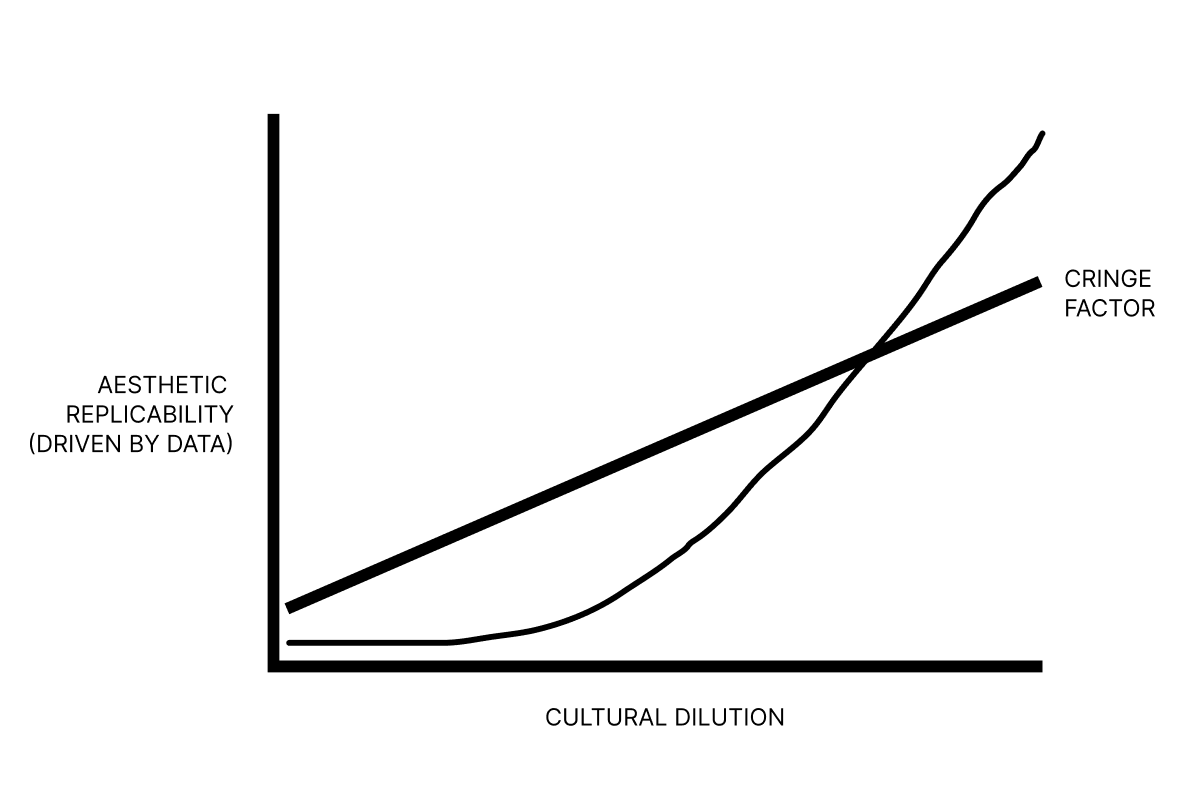
In contrast to that, streetwear and crypto share the maximalist, spontaneous aesthetic that rejects the Lifestyle era’s templatized design systems. The death of the logo* is part of this design systems-based brand collapse. Facebook’s icon will indeed elicit legibility in most people for a long time, but this is a story of distribution (2.96 billion MAUs) and age (founded in 2004). This is also a story of an increasingly irrelevant playbook for building culturally enduring digital institutions. Facebook does have a globally recognizable brand mark, but it’s primarily a commodity distribution platform—a technological and cultural relic.
Returning to the Pleasures site, there is little continuity within the shirt category alone. Gothic font, brown cable knits, “cowboys on acid,” a screen printed grid of realistic small dogs, basketballs, hunting vests. Trad branding wisdom advises heavily against such lawless brand expression lest you alienate or confuse your target demographic. Explain this then: while I’m not going to buy a black tee with criss-crossing skeleton arms flipping the bird, if I see you wearing it, I will for sure say, “Hey,” with intentions of talking to you about Pleasures.
Like many streetwear brands, the most enduring cultural crypto brands will not be built on an irrefutable design system—one that could be generated to near completion using GPT-4, like a Canva template. They’ll be built on the constantly innovating tastes of the humans within the brand, evolving multi-hyphenate, immersive, and emergent expression across every interaction, digital and physical.
This is all to say: we have a new brand-building roadmap, one that looks like no roadmap at all. More crypto brands will appear irrational, much like their primitive human creators. We’re in our meta-cringe, post-post-irony maximalist brand era. Sometimes cringe is actually based. Luxury can now be a public good; many public goods are now luxuries. Anything and everything goes in culture, so long as you have people who see themselves in it and will do something as nonsensical as pay $10,000 for a cartoon penguin jpeg. (More on that later down.)
*But don’t conflate logo-death with blanding.
Emotional Utility
Over the past decade, streetwear brands and crypto projects have experienced explosive growth due to the value they offer consumers. This value can be broken down into two distinct categories: financial utility and emotional utility.
The financial utility refers to the potential for making money through means such as reselling or airdrops. Meanwhile, emotional utility revolves around the feelings of status, self-expression, and belonging that these products and projects provide.
The streetwear market has flourished for years, largely due to the high emotional utility it offers. Brands like Off-White and Supreme have become synonymous with a certain level of taste and financial status, as their products allow individuals to express their personal style and elevate their social standing. These fashion statements reflect a deeper connection with the culture and community surrounding the brands, fostering a sense of belonging among their enthusiasts.
Similarly, NFT projects deliver emotional utility through various channels like Discord, Twitter, and IRL events. These environments enable individuals to connect with like-minded people, share their passions, and create a sense of camaraderie.
As the next generation of NFT brands emerges, it is crucial for them to lean more heavily into emotional utility, prioritizing social experiences and cultural relevance.
Here are a couple of our favorite recent examples that showcase the potential of prioritizing emotional utility:
- DeGods NFT NYC event. The DeGods team reserved three floors of The Public Hotel during NFT NYC, providing a unique benefit to community members. With a thoughtfully planned three-day agenda, they aim to cultivate deeper connections among the community. By blending online and physical touchpoints, DeGods sought to recreate the captivating essence of college social life, showcasing a prime example of their vision in action.
- Pudgy Penguins’ social media strategy and physical collectibles. Unlike other NFT brands, Pudgy Penguins is heavily investing in marketing to mainstream consumers through channels like Instagram and Giphy. Through heartwarming and uplifting content, the Pudgy IP has reached 3.1B views on Giphy and grown to over 300K Instagram followers. This increasing cultural awareness has enabled them to sign partnerships with some of the top manufacturers and retailers to sell Pudgy toys online and in-store to a mass audience. Pudgy sets itself apart from other NFT brands, focusing on carving its own niche. Through social media marketing and web3 technology, Pudgy has the potential to become a modern incarnation of iconic IP giants, such as Hello Kitty.
Over the next couple of years, I believe we’ll continue to see NFT brands invest in social experiences and cultural relevance. By leaning into emotional utility, brands can build stronger, more engaged communities and secure their positions in an increasingly competitive market.
Go-to-market
Streetwear culture and crypto brands have many notable similarities in their go-to-market strategies. Both industries have successfully leveraged the appeal of exclusivity and scarcity, creating a sense of urgency among their audiences.
Limited edition drops serve as a driving force in streetwear, with brands like Supreme releasing biweekly collections in restricted quantities and at accessible prices. This approach ensures the products remain exclusive while also proliferating the brand's presence through high demand and rapid circulation through resale platforms. Similarly, the crypto world has embraced the concept of 10K PFP collections, characterized by a limited supply and low minting prices. This strategy allows for rapid brand proliferation as users showcase their unique PFPs on platforms like Twitter while using their floor price as a marketing surface to attract new members.
Influencer marketing also plays a crucial role in both industries, as they harness the power of celebrity endorsements and social media presence. Streetwear brands often collaborate with high profile individuals, utilizing their influence through social media posts, lookbooks, and video campaigns to promote upcoming drops. Likewise, NFT brands reserve a portion of their collections to gift to prominent influencers, who, in turn, introduce the brand to their audience. This approach helps build credibility and trust while fueling the hype surrounding the exclusive products and projects.
We in the future envision more extensive collaborations between web2 and web3 brands, aiming to cross-promote to similar audiences. In 2017, LVMH pioneered the recent wave of luxury brand collaborations with streetwear through their Louis Vuitton x Supreme collection. LVMH continues to innovate, as demonstrated by their recent Tiffany & Co. x Cryptopunks pendant collaboration.
The shared marketing strategies between streetwear and crypto brands demonstrate a deep understanding of consumer psychology and the value of exclusivity. Next generation brands that learn from these tactics will have a much better chance of capturing the attention and imagination of enthusiasts and casual observers alike.
The Next Wave
We’re primed to lean into our maximalist tendencies to build the next wave of consumer adoption. While the mainstream zeitgeist hand waves at our jpegs and downplays cultural use cases, we should double down on our already intuitive counter cultural narrative. The next wave of consumer crypto adoption will be centered around culture.
*gm to Baukunst, Eugene Angelo, and Reggie James for the talk that inspired this title.

